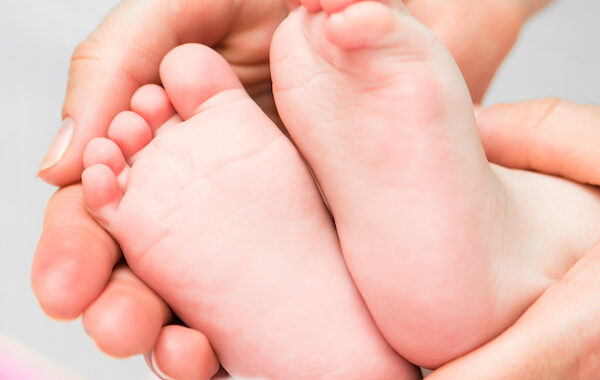Flat feet (also known as pronation, flexible flat foot, and pes planus) is a common foot condition characterized by a lack of arch in the foot. Every child is born with flat feet, and they start to develop an arch at the age of three.
Flat feet in children usually disappear by the age of six, and only 1 or 2 out of every 10 children will still have flat feet into adulthood. There are two kinds of flat feet — rigid and flexible. The latter is normal and should not be alarming. The former, however, may have an underlying bone or joint disease that needs treatment. Continue reading this blog to learn everything you need to know about flat feet in children:
Is It a Disability?
Because a child’s foot arches do not fully develop until the age of six, they naturally have flat feet — the condition corrects itself with age. However, if a child is older than six or seven years old and still has flat feet, it is due to a heel abnormality in which the calcaneus (heel bone) rotates inward, causing the arch to collapse. So, while flat feet are a deformity or anomaly of the heel, they are not a disability.
Causes
- Low muscle tone (hypotonia): Ligaments or connective tissues in children with low muscle tone are slightly more elastic, allowing joint motion beyond the typical range. This atypical motion can cause the calcaneus to rotate inwards, causing an arch collapse and flat feet.
- High muscle tone (hypertonia): In children with high muscle tone, the Achilles tendon is too short and pulls the foot inward, causing the arch to collapse and flat feet to develop.
- Joint hypermobility: When a child’s feet have hypermobile joints, the ligaments that keep the joints together are excessively loose. The arch collapses under the body weight, resulting in flat feet.
- Heredity: Flat feet are inherited by some children from their parents.
- Overweight: Studies indicate that overweight children are more likely to have flat feet. Children’s feet develop normally as they grow older, although they can still have flat feet as an adult due to some systemic conditions. Obesity, diabetes, rheumatoid arthritis, foot or ankle injuries, and the aging process are a few examples.
Signs and Symptoms
While most children with flat feet show no symptoms, the following are some of the most commonly observed ones:
- Pain and discomfort in the heel, foot and/or knee
- Heel that points outward
- Abnormal gait
- Difficulty walking in different styles of footwear
- Inefficiency or inability to run fast when compared to other children
- Lowered energy levels while participating in high-intensity physical activities
- Withdrawal or lack of desire in participating in physical activities
Risks and Complications
Your child’s posture, manner of walking, and muscle health could be compromised by flat feet. The condition could trigger a series of complications that include:
- Disabling joint pains
- Decreased strength in the muscles
- Fatigue
- Gait abnormalities like limp
- Development delays
Diagnosis
Children with flat feet are usually diagnosed when they are six or seven years old. The arches in the child’s feet form as the child grows and their bones develop. Although there is no minimum age for diagnosing flat feet in children, most parents consult their podiatric physician or pediatrician if the condition is not resolved by the time their child is ten or eleven years old.
Physical examination and X-rays are commonly used to diagnose flat feet. A foot and ankle surgeon will examine the child’s feet and how they stand, sit, and walk. They will also look at the child’s range of motion (ROM). X-rays may be required to identify any foot deformities. Rigid flat feet typically necessitate additional examination. If the child’s flat feet cause knee and hip problems, or if the child exhibits signs of neuromuscular disorders, X-rays and other tests may be performed.
Treatment
Based on the nature and severity of the condition, there are two forms of treatment for flat feet in children:
Non-surgical methods: These are usually recommended when the child exhibits no symptoms and the condition is being monitored regularly by the foot and ankle surgeon. If the child does exhibit signs of flat feet, the surgeon may assess the problem and recommend any of the non-surgical therapy methods listed below:
- Adjustments in the child’s activities
- Use of custom orthotics
- Physiotherapy
- Medications
- Use of different types of footwear
Surgery: Surgical intervention for flat feet in children is only advised when non-surgical methods are unsuccessful, or the child is experiencing disabling aches and pains because of them. The following surgical procedures are commonly performed to correct flat feet in children:
- Tendon repair surgery to treat a torn or otherwise damaged tendon
- Ankle fusion or ankle arthrodesis to fuse the bones of your ankle into one piece
- Osteotomy (“bone cutting”) to shorten or lengthen the bone or change its alignment
- Achilles tendon lengthening (ATL) to lengthen or replace the tendons
Home Care
Most children with flat feet do not exhibit any symptoms and thus do not require surgical therapy. That being said, since their feet are flexible, parents can employ the following home care management approaches to help their child (after consulting with a podiatric physician or pediatrician):
- Prescription custom orthotics and shoe inserts
- Wearing footwear that is well-fitting and allows the feet to breathe
- Wearing ankle-foot brace
Shop at FootDocStore
Visit the FootDocStore.com online store to find a wide selection of foot pain relief and comfort solutions. Also, be sure to check out our blog to learn more about how to keep your children’s feet and ankles healthy and happy.

